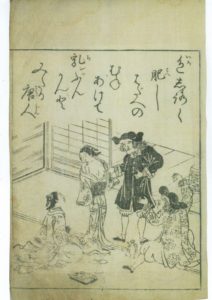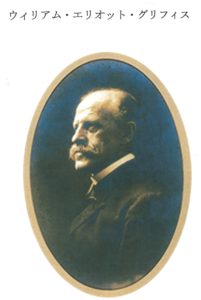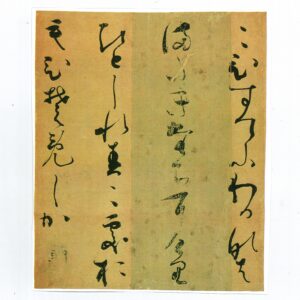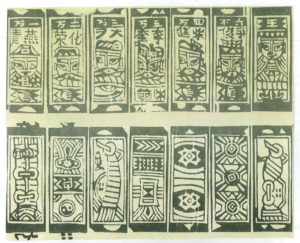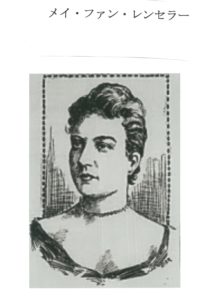(3) Summary
The 18th century was the peak of gambling carta games in the Edo period after the law on the death penalty that had been imposed since the start of the Tokugawa Shogunate government was repealed. At the time of the reform of the Kyoho era, the Shogunate government developed a code of criminal law modelled on the law of the Chinese Qing. In this newly established criminal law, they punished gambling criminals lightly with ‘100 spanks on the back or buttocks’, and came to punish a minor gambling game for less than 50 Mon with only an official rebuke. In addition, the production and sale of gambling game equipment was not prohibited. According to the change of policy of the Shogunate government, gambling carta games spread in urban areas, mainly in Kyoto, Osaka, Nagoya, and Edo. In the early years of the 18th century, playing techniques derived from Namban carta, namely Awase Carta and Yomi Carta, became popular all over the country, and in the middle of the 18th century, the fashion shifted to Awase (Tensho) Carta in western Japan, and in the case of Edo, Mekuri Carta, which were modified Awase (Tensho) Carta of western Japan, developed independently, and then spread throughout the country.
The late 18th century when Thvnberg came to Japan was the peak of gambling game carta. The extent of the activity is clear from the many literary works and documentary materials. Unfortunately, however, there are no extant carta cards from the gambling games of this time, and therefore, the lively scenes of gambling carta games at that time cannot be envisioned. There is no such carta in the collection of Kichirobei Yamaguchi and his son, Kakutarou Yamaguchi, of Ashiya City, Hyogo Prefecture, which is the best collection that revolutionized the research of the history of carta in Japan, and it is not in the collection of the Japan Playing Card Museum that I sponsor, too.
The importance of the information provided by the set of carta cards found by Markus Richert in the Swedish museum collection is clear. For the first time, carta history researchers obtained a surviving historical material that realistically shows the actual situation of this gambling game in its heyday in the Edo period. The historical value and meaning have already been described above. Carl Peter Thvnberg’s name will long be revered as one of the most important pioneers of carta history research. His collection of carta cards is decisive evidence of his diary descriptions of actual scenes as a record of the Awase Carta game. Markus Richert’s discovery of this carta opened the door to a new era of research. Many discussions will be held and many articles will be written. The present short report is merely the start of a new stage of international research on the history of Japanese carta.
Supplement
I wish to write a supplement for this article. The image on the right depicts two Dutch people from Dejima, Nagasaki in the mid 18th century, drawn by a famous painter, Nishikawa Sukenobu. They are enjoying a banquet with prostitutes at a Yukaku (licensed prostitution district) or Yuri (hidden prostitution house located outside of Yukaku) in the city. The source is ‘Ike no Kawazu’, which was published by Kihei Kikuya in 1768. As Thvnberg first came to Japan in 1775, the model of this picture is not Thvnberg but another person.
‘Ike no Kawazu’ has a comic tanka(poem) at the top and a related picture at the bottom for each page. The comic tanka can be read as ‘Iroshiroku kohesihadaheno muneakete chinpunkanto mitarutoujin’. The meaning of these words is ‘Dutch men forcibly opened the clothes of a young fair skinned, plump prostitute and looked over her breasts, but the prostitutes could not understand their explanation at all’. Although it says ‘Tojin’ (Chinese), of course, this is ‘Dutch person’, and since they speak only Dutch, the prostitutes are drawn to be embarrassed about what to do. The place depicted would be Maruyama Yukaku, a licensed prostitution district or the unofficial secret dating place, Yuri, beside it. The latter, which was not closely monitored by the magistrate’s office, would have been more convenient for Dutch people who wished to relax.
I conjecture as follows. The Dutch people depicted are old and young, and as they wear different types of clothes, they may have been of different ranks. I think one may have been a doctor at the Dutch merchant house and the other a clerk at the house. The Dutch were not allowed to leave Dejima under the rules; prostitutes of Maruyama Yukaku were supposed to go to Dejima for services, but the ban was considerably loosened in the middle of the Edo period. It would have been permissible to be entertained at the playground in the city, free from being trapped in Dejima. Even in this picture, the Dutch are fooling around as they like.
I suspect this was a doctor at the Dutch Merchant House. A doctor and his assistant could have more easily escaped from Dejima. Doctors had a good excuse for home visits, and it would have been difficult for the magistrate’s office to forbid this directly. If prohibited, a person from the magistrate’s office or his family would, upon falling ill, not have been able to receive medical treatment by a Dutch doctor. Therefore, the Dutch could have said ‘It’s a home visit’ like a free pass. The clerk of the merchant house then suddenly became a medical assistant and could breathe the air outside Dejima with the doctor. Then, at the banquet in Yukaku or Yuri, the Dutch asked for a prostitute to reveal her breasts as if for medical treatment. There are lewd doctors everywhere in both the East and West.
If orchids in Nagasaki were treated loosely as shown in this picture, Japanese carta could have been found at banquets in Yukaku or Yuri. In the case of Thvnberg, he might have remembered the experience at Kaminoseki Port on the way to Edo, and wished to take the carta as a souvenir back to his country. It must have been easy for them to get hold of a deck and take it back to Dejima.
From this episode, I hope you can feel the relaxed atmosphere of Nagasaki at the time of Thvnberg’s arrival.
/ /// /

